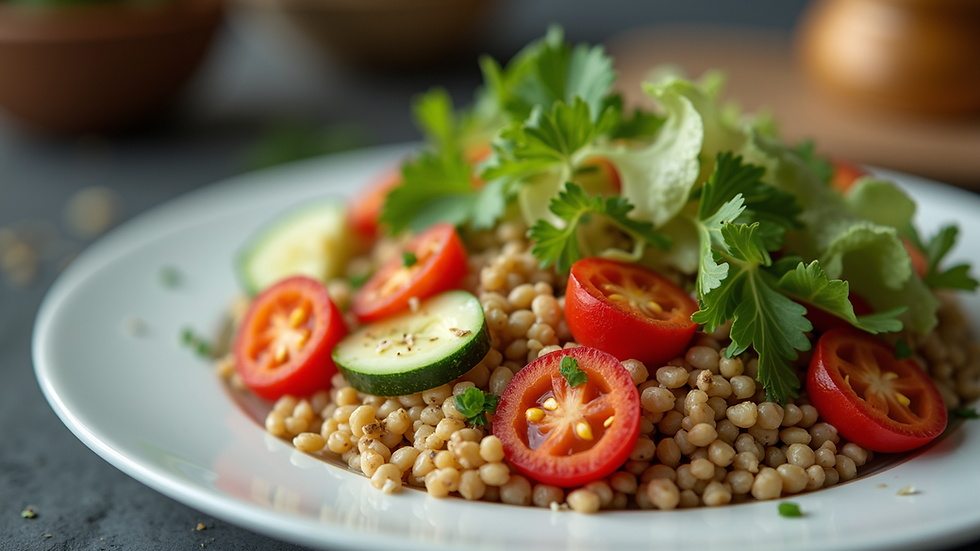How to Create the Perfect Weekly Meal Prep Routine
- Ivona Tarnaj

- May 6
- 4 min read
Meal prepping can significantly streamline your weekly cooking routine, save you time, and promote healthier eating habits. By preparing meals in advance, you can avoid the stress of last-minute cooking and make better food choices. In this guide, we will explore how to create the perfect weekly meal prep routine that suits your lifestyle.
Understanding a Meal Prep Routine
Creating a meal prep routine is essential for anyone looking to maintain a balanced diet. It involves planning your meals ahead of time, shopping for necessary ingredients, and dedicating a specific day to prepare them. This routine can help you save time during the week and ensure you’re consuming nutritious meals.
A study by the International Journal of Behavioral Nutrition and Physical Activity found that meal prep can lead to healthier eating habits. Those who prepared meals weekly had higher fruit and vegetable intake and lower fat consumption.

Steps to Create an Effective Meal Prep Routine
1. Design a Weekly Schedule
The first step in developing an effective meal prep routine is to design a schedule. Choose one day a week that will be your primary meal prep day – many people find Sundays work well.
During your prep day, set aside a block of time, typically 2-4 hours, to focus on preparing meals. This time can include shopping, cooking, and storing the food.
2. Choose Your Meals Wisely
A crucial aspect of meal prep is selecting meals that are suitable for storing and reheating. Opt for recipes that stay fresh throughout the week. Consider the following:
Grains: Quinoa, brown rice, and whole-grain pasta all store well.
Proteins: Chicken, turkey, tofu, and legumes can be cooked in bulk.
Vegetables: Roasted or steamed vegetables, like broccoli and bell peppers, retain their quality.
It's also helpful to cook meals that can be easily mixed and matched. For example, grilled chicken can be used in salads, wraps, or over rice.

How do I create a personalized meal plan?
Creating a personalized meal plan requires understanding your dietary needs and preferences. Here are some steps to help you create one:
Assess Your Dietary Needs: Consider any dietary restrictions or preferences you may have. This includes allergies, vegan or gluten-free choices, and general dietary goals.
Set Nutrition Goals: Define what you want to achieve through your meal prep. This could be weight loss, muscle gain, or simply maintaining a balanced diet.
Create Your Meal Templates: Start with a basic template for your meals. For instance, a simple template could include:
Protein source (grilled chicken, beans)
Carbohydrate (quinoa, sweet potatoes)
Vegetable (spinach, carrots)
Incorporate Variety: To prevent boredom, rotate your meal options weekly. Use different spices or preparation methods to keep meals exciting.
Document Your Plan: Write down your meals for the week. You can use a spreadsheet or a meal planning app.
Adapt as Necessary: After a few weeks, reassess your plan. Make adjustments based on what you enjoyed or what worked and what didn’t.

Grocery Shopping for Meal Prep
Once you have your meal plan outlined, it’s time to shop. Having a detailed grocery list can save you time in the store and minimize impulse buys. Here are some tips:
Stick to Your List: Write down everything you need based on your meal plan.
Shop the Perimeter: Fresh produce, proteins, and healthy fats are usually found around the outside of grocery stores. Avoid the inner aisles, which often contain processed foods.
Buy in Bulk: If you have the storage space, consider buying grains, legumes, and proteins in bulk to save money.
Organizing Your Meal Prep Space
Creating an efficient meal prep space can save you time and hassle. Here are a few tips:
Create Your Workflow: Set up your cooking station in a way that flows. Start with washing and chopping vegetables, then cook your proteins, followed by grains.
Keep It Clean: Clean as you go to make the process more enjoyable and efficient.
Label Containers: Use clear containers and label them with the meal and date. This helps to keep track of freshness.
Health Benefits of Meal Prepping
The benefits of meal prepping extend beyond just convenience. Here are a few health advantages:
Portion Control: Pre-portioned meals help prevent overeating and make it easier to manage calorie intake.
Balanced Nutrition: Planning meals allows you to incorporate a variety of food groups, ensuring a balanced diet.
Less Food Waste: By prepping meals, you’re more likely to use the ingredients you buy, reducing food waste.
Maintaining the Routine
Staying consistent with your meal prep routine can be a challenge, but keeping it enjoyable and adaptable is key. Here are some ideas:
Involve Family: If possible, get family members involved in the meal prep process. It can be a fun and collaborative experience.
Experiment: Try new recipes regularly to keep meals exciting.
Set Reminders: Use your phone or calendar to remind you when it’s time to meal prep.
Meal prepping offers a fantastic opportunity to enjoy healthy meals without the hassle of cooking every day. As you become more familiar with your routine, you’ll find it easier to adjust as needed. Over time, you can refine your process to fit comfortably into your lifestyle, allowing you to enjoy the many benefits of nutritious eating without stress.
Creating a weekly meal prep routine allows you the freedom to enjoy healthy meals without consuming your precious free time each day. With the right planning and preparation, you’ll not only eat healthier but also save money and reduce stress in the kitchen. To simplify your journey even further, consider checking out custom meal plans tailored to fit your individual needs and preferences.



Comments